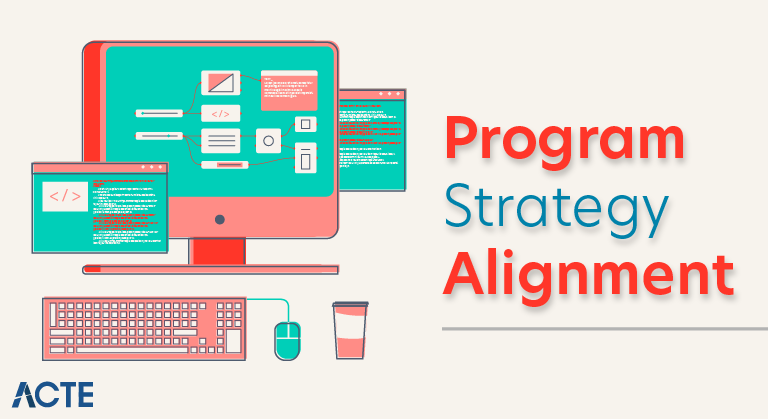
What is strategy?
Understanding strategic alignment starts with understanding what strategy really is. Most people think of “vision statements” and “mission statements” as being “strategy” but they are only a small part of the “strategy story”. Your mission and vision are simply statements about what your organization is for and where the executives would like to take it.
Strategy – in the context of “strategic alignment” – is the “how”.
For example, our vision/mission might say something like: We want to be the most profitable widget manufacturer in the world?
The key question we need to ask before we can take any action to implement this strategic vision is, “How should we do that”? In the case of our widget manufacturer, we could ask, “Are we going to be the lowest cost provider and take massive market share… or should we be the one that offers the highest level of Widget Service, but does so at a high margin?”
The “how” statements lead you to strategic goals – the specific targets you have to hit to achieve your vision/mission.Let’s say that we decide we’re going to be the low-cost, high volume widget maker, that means our strategic goals might be something like:
- Reduce costs to supply widgets
- Increase distribution channels
- Manage cash flow (as volume grows, your organization will need more cash to hold stock, etc.)
In the real world, you’d probably want to put some specific numbers on these goals, but this “big picture” of what we’re trying to achieve (be the most profitable widget company) combined with a high-level statement of how we’re going to achieve it (by being low cost, increasing distribution while managing cash) is your “strategy”.
Now of course, there is a lot more to strategy than we’ve set out here, but this is enough for our purposes in this document. We don’t really need to go through the whole strategic planning process to get an understanding of strategic alignment. The key thing is that we’ve identified a small number of strategic goals…
What is strategic alignment?
Having a strategy is not enough. In fact, research suggests that having a strategy has no real effect on the performance of your business. It’s aligning your activities to your strategies that makes the difference.
Now that’s a pretty big statement, but actually it’s also pretty obvious if you think about it.
Look at it this way; deciding you want a cup of coffee (your strategy) is not the same as getting up and making a cup of coffee (aligning your actions to your strategy).
This gets to the heart of what strategic alignment is. Most people think of strategic alignment as a noun (“the state of having everything aligned to strategy”), but it’s better to think of strategic alignment as a verb – it’s about action. Here’s my definition:
STRATEGIC ALIGNMENT (verb): The process of aligning an organization’s decisions and actions such that they support the achievement of strategic goals.
Note that the definition talks about decision-making and actions. Actions typically follow decisions so if your organization doesn’t have the ability to make well-aligned decisions, they really can’t take well-aligned actions.
Note also that, implicit in the definition, is the fact that strategic alignment involves NOT DOING some of the things that you might currently be doing… things that do not support the realization of strategic goals.
Why does strategic alignment matter?
There has, over the last few decades, been a lot of academic research into the effects of strategic alignment on organizational performance. There are some really powerful conclusions:
- One study found that the level of strategic alignment of an organization explains up to 80% of the difference in performance between organizations. This is a quite startling result.
- Another study found that 51% of the difference in organizations’ performance can be explained by strategic alignment and another 38% can be explained by the level of consensus / buy-in. So alignment is important, but so is buy-in and support – together they explained around 90% of the variation in operational results of organizations.
- A third study shows that 18% of the difference between the overall performance of organizations is explained by the level of strategic alignment between their business goals and the activities undertaken by the IT department. So, aligning your IT investments to support your strategy really is important.
We could go on – there are many studies into the impact of strategic alignment – but I think the message is clear. Strategic alignment matters because it is very strongly linked to improved business results.
I would also suggest that strategic alignment matters because, in principle, it is very easy to fix. You don’t need big reorganizations of your company. You don’t need to overhaul your IT systems. You don’t need to retrain hundreds of people…
You just need to put your strategic goals at the heart of everything you do. But of course, that’s not quite as simple as it sounds.
Why Strategic Alignment Is Important
Organizations that are strategically aligned operate more efficiently and achieve better outcomes because people and teams develop action plans that are focused on achieving common goals and objectives. Without strategic alignment, people become confused about their priorities, make fewer effective decisions, and likely engage in more conflict. This eventually leads to fatigue and causes people to lose their passion and the motivation to do their best work. People want to be connected to something they believe in. Strategic alignment helps strengthen engagement by
- informing people who develop products and services.
- providing direction for sales and marketing.
- helping people on the operation side of the business develop the best practices and allocate resources.
In essence, strategic alignment enables every member and team to help the business create value for owners, customers, workers, and community and contribute to the plan to win.
A business is like a machine with a lot of moving parts. When the parts or activities of a business are aligned, there is less friction and tension. A business has to be a well-oiled machine in order to be profitable, generate cash flow, invest in growth opportunities, and bring new products and services to the marketplace. Alignment and coordination are essential to long-term survival and prosperity. Without alignment, organizations atrophy and create more waste. Left unattended, this leads to less vitality, degeneration, and potential failure of the enterprise. Organizations that invest some time and energy to achieve strategic alignment create a competitive advantage, achieve greater differentiation, create unique capabilities, and deliver more value for its stakeholders.
What are our strategic goals?
In an ideal world, your strategic goals will flow from your strategic planning process, but in most large organizations, strategic planning is not really done properly leaving most managers wondering how “big strategic statements” affect them.
[In the section on strategic planning, we look at how things should work in an ideal world. For the rest of this section, let’s assume that the strategic planning process doesn’t really cascade through the organization effectively.]
There are some things you can do to identify your own strategic goals even if the overall strategic planning process isn’t giving you what you need. There are two steps; first you need to identify your strategic goals, then you need to assess the relative importance of your goals. This second step is really important (and is often left out) because it’s the weights / relative importance of your goals that helps your team make clear, consistent and well-aligned decisions.
Program strategy alignment
Program strategy alignment is a program performance domain that is initiated during the program definition phase with the development of the business case, program charter and program roadmap, supported with the inputs from environmental assessments and program risk management strategy.
The effort results in the development of a program management plan that is aligned with organizational goals and objectives.

Environmental Analysis
The following sections outline various forms of analysis that may be used to assess the validity of a program’s business case and program management plan.
- Comparative Advantage Analysis: Where appropriate, comparative advantage analysis may also include what-if analyses to illustrate how the program’s objectives and intended benefits could be achieved by other means.
- Feasibility Studies: Using the business case, organizational goals, and other existing initiatives as a base, this process assesses the feasibility of the program within the organization’s financial, sourcing, complexity, and constraint profile.
- Swot Analysis: An analysis of the strengths, weaknesses, opportunities, and threats (SWOT) faced by a program provides information for optimizing the program charter and program management plan.
- Assumptions Analysis: Program managers regularly identify and document assumptions as part of their planning process. In addition, assumptions should be validated during the course of the program to ensure that the assumptions have not been invalidated by events or other program activities.
- Historical Information: Analysis Historical information includes artifacts, metrics, risks, and estimations from previous programs, projects, and ongoing operations that may be relevant to the current program. Historical information describing the successes, failures, and lessons learned is particularly important during program definition.
Program Risk Management Strategy
Successful delivery of the program roadmap, aligned with organizational strategy, and with consideration to the environmental factors found in the environmental assessments, depends on a well-defined program risk strategy.
- Risk Management For Strategy Alignment: This risk management strategy includes defining program risk thresholds, performing the initial program risk assessment, and developing a high-level program risk response strategy.
- Program Risk Thresholds: Risk threshold is the measure of the degree of acceptable variation around a program objective that reflects the risk appetite of the organization and program stakeholders.
- Initial Program Risk Assessment: While program risk management is conducted throughout the life of the program, the initial program risk assessment, prepared during program definition, offers a unique opportunity to identify risks to organizational strategy alignment.
- Program Risk Response Strategy : Program risk response strategy combines the elements of the risk thresholds and the initial risk assessment into a plan for how program risks will be managed effectively and consistently throughout the life of the program.
- For each identified risk, the risk thresholds can be used to identify the specific response strategy based on a number of rating criteria.
- A robust program risk management strategy comprises a specific risk response strategy for each of the risk rating levels that have been developed to reflect the program’s risk thresholds.
Program Strategy Alignment – Activities and Artifacts
We know that program strategy alignment is a key process area within program management. In fact, this is one of those processes that distinguishes a program and a program manager from a project and a project manager. Although program strategy alignment is a much deeper area, here we include a summary of those activities and artifacts that a program manager typically works on to help align the program with the organization strategy. They are:
- Program inception from Organizational Strategy – This refers to ensuring that a program or initiative selected for execution is derived from an organization’s strategy. Since most programs require a large investment, an organization needs to ensure that its investments support an organization’s strategy.
- Develop Business Case – This refers to the creation of the business case to justify the investment in the program. Again, the large investment requires a business justification that must be documented in a business case document.
- Develop Program Plan – This document is about documenting a high level plan for the program and its benefits. This document can then be used as a reference for the rest of the program’s duration and thus it ensures that the program stays aligned to the original plan.
- Develop Program Roadmap – This activity and document is about creating a high level timeline of the program by highlighting the key milestones when the program’s benefits are realized throughout the duration of the program.
- Perform Environmental Assessments – This activity is about performing environmental assessments to get clarity on the context of the overall program within the organization as well as the external environment.
- Constant Program Monitoring – This is about the program manager constantly monitoring the various activities of the program to ensure they don’t deviate from the main goals and objectives of the organization.
- Update Key Documents As Needed – This is about constantly updating documents and other artifacts of the program to meet the organization’s overall strategy.
Need for strategic alignment
Organizations around the world are challenged to adapt to the changing business environment at a breakneck pace. Consequently, having team members who understand and are in alignment with the business’ principal strategy is increasingly more important. In order to stay competitive, organizations must devise viable, creative strategies for business success and growth. Organizations with a strategic plan are more likely to achieve long-term sustained growth and profitability. The plan should reflect and encompass the three essential building blocks of a successful business: people, product and processes. And for corporate strategy to do its job, an organization must maintain strategic alignment throughout every level of the business.
Benefits
Lacking strategic alignment, well-meaning managers may spend countless hours pursuing initiatives that, while they may be good ideas, aren’t the right things to focus on at the time. Even worse, if the strategy of the organization is unclear to employees at the operational level, they may lose faith in the vision, mission, and value proposition of the organization. This loss of connection can squelch their morale and willingness to offer their best to the company, which not only hurts the company culture—it hurts the bottom line. By ensuring that there is strategic alignment in your organization, you can be certain that limited resources won’t go to waste:
- Focus energy in the right areas at the right times
- Reduce or abolish workplace redundancies
- Eliminate conflicting priorities
- Increase team-member coordination, communication, and buy-in
- Clarify the capabilities and competitive advantages of the organization
- Provide structure and clarity of purpose for employees
- Empower all team members to shape the future of the organization
- Support market maneuverability, a must in a rapidly changing global economy
Conclusion
The business environment is rapidly changing with very short life cycles. This creates a new burden on corporations to chase after these changes at a quicker pace, or to otherwise get out of the market. For this reason, lengthy and complicated processes causing decisions and implementation delays are no longer accepted, and the need for quicker more efficient techniques are highly required. This paper has highlighted a new proposed technique for filling this basic need in the hope of helping corporations keep up the required pace.
The model used here provides a quick method to select the optimal projects combination; still the responsibility of this model handling and implementation is divided among higher executives, portfolio managers, operations managers, and project managers, which creates a new requirement to coordinate and gather all these responsible people to apply the new model.
This is considered to be a new challenge for the project management office (PMO), and hence further research is required for the role of the PMO in implementing this model.





